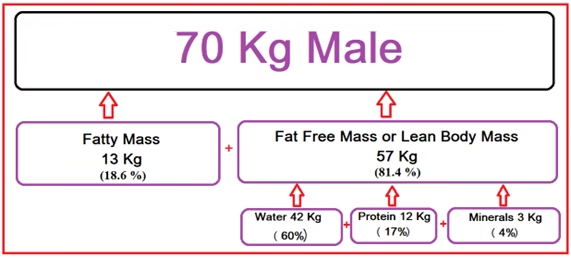The term body composition is used to describe the different tissue components of the body that creates a person’s total body weight or the relative proportions of water, protein, fat, minerals, bone, and muscle mass. After a major injury or critical illness, several changes occur in body’s composition.
Normal human body composition|Two-component model
The term body composition describes the different components of the body that make up a person’s total body weight. There are two, three-, or four-component models to describe normal human body composition. The two-component model has the widest acceptance to characterize human body composition in most settings.
The two-component model divides body mass into Fat Mass and Fat-Free Mass (FFM) or Lean Body Mass (LBM). FFM referees to “lean tissue,”. It includes water, muscle, bone, connective tissue, and internal organs.
Body composition of an adult male

The body of an average 70¬kg male consists of 13 kg Fat Mass and 57 kg Fat free mass (FFM) or Lean Body Mass (LBM). The lean tissue or Lean Body Mass is made up of 42 kg water, 12 kg protein, and 3 kg minerals. The protein mass consists of two main compartments, skeletal muscle protein (4 kg) and nonskeletal muscle protein (8 kg) including visceral protein mass.
Total water mass (42 litres) is divided into intracellular (28 litres) and extracellular (14 litres) spaces.
Most of the mineral mass resides in the bony skeletal tissue.
‘Water mass’ and ‘Protein mass’


Labile/Metabolically active reserve mass
The main labile or changeable or metabolically active energy reserve in the body is fat, and the main changeable protein reserve is skeletal muscle. Loss of fat mass has no major harmful effects while loss of protein mass results in skeletal muscle wasting and depletion of visceral proteins.
Within the wet lean issue, each 6.25 g of protein represents 1 g (16%) of nitrogen. Thus, the loss of 1 g of nitrogen in urine is equivalent to the breakdown of 36 g of wet lean tissue. The loss of lean tissue and urinary protein loss, are typically seen in severe trauma and critical illness and usually represent a loss of functioning proteins and amino acids.
The protein turnover rate in the human body is about 150–200 g per day. A normal human ingests about 70–100 g protein per day and excretes approximately 14 g N/day in urine as ammonia and urea.
Body response after major trauma and critical illness
After major trauma, prolonged sepsis and critical Illness the adaptive metabolic changes known as Compensatory Anti-Inflammatory Response Syndrome (“or CARS”) that lead to repair and recovery fails to take place and a state of ‘auto-cannibalism’ follows.
There is continued loss of 10–20 g urinary nitrogen /day (equivalent to 500 g of wet lean tissue mass per day).
Initially the body weight increases on fluid resuscitation due to expansion of extracellular water. Thereafter, despite optimal nutritional support, total body protein falls by 15% during the next 10 days due to the cessation of expansion of the extracellular water space. This results in muscle wasting and weight loss.
It is now possible to maintain body weight and nitrogen balance following major elective surgery by blocking the neuro-endocrine stress response with epidural analgesia or other related techniques. This facilitates early oral or enteral feeding.
It is noteworthy that the early fluid retention phase after elective surgery can be avoided by careful intraoperative management of fluid balance, with avoidance of excessive administration of intravenous saline.


Leave a Reply